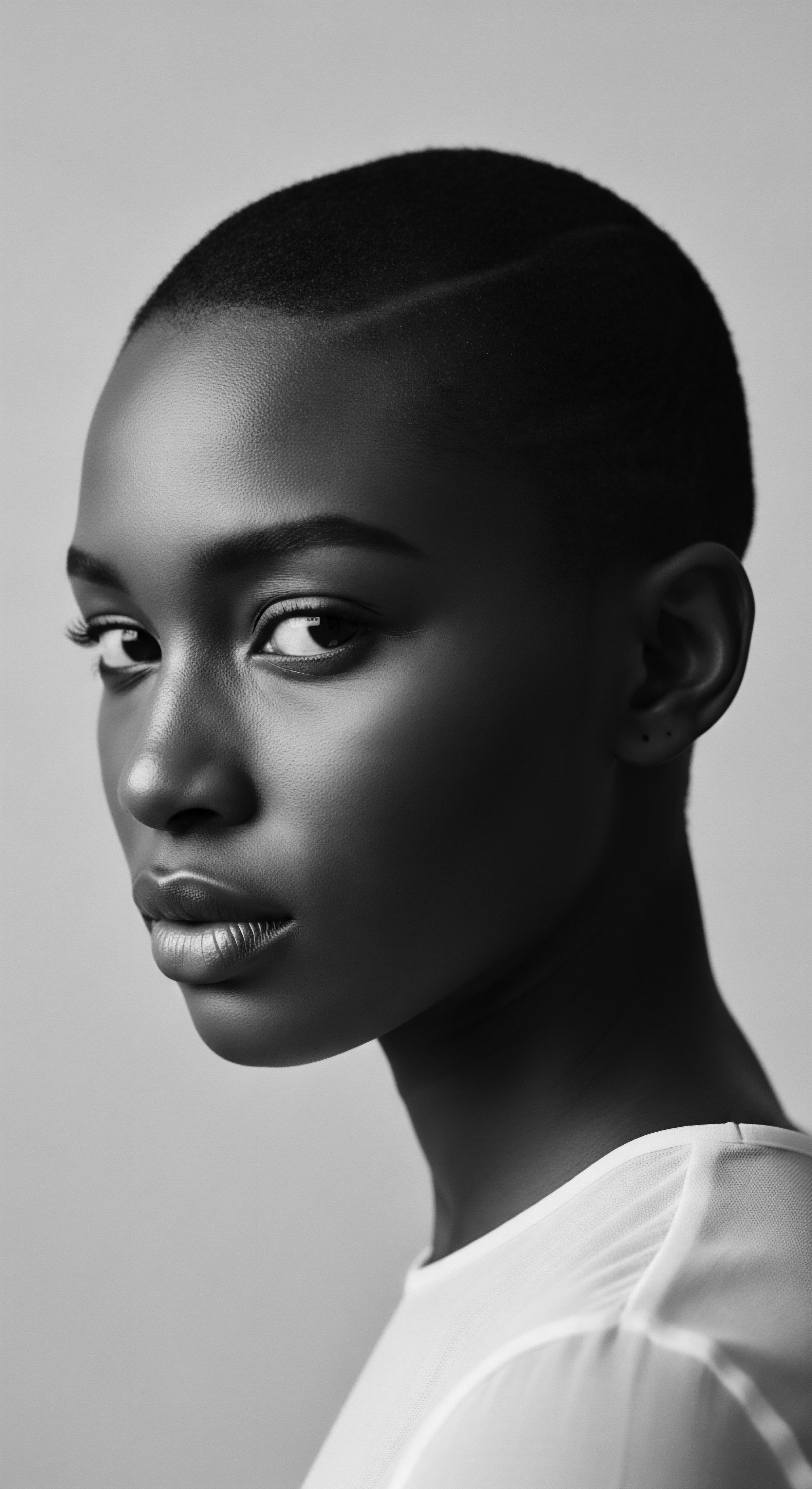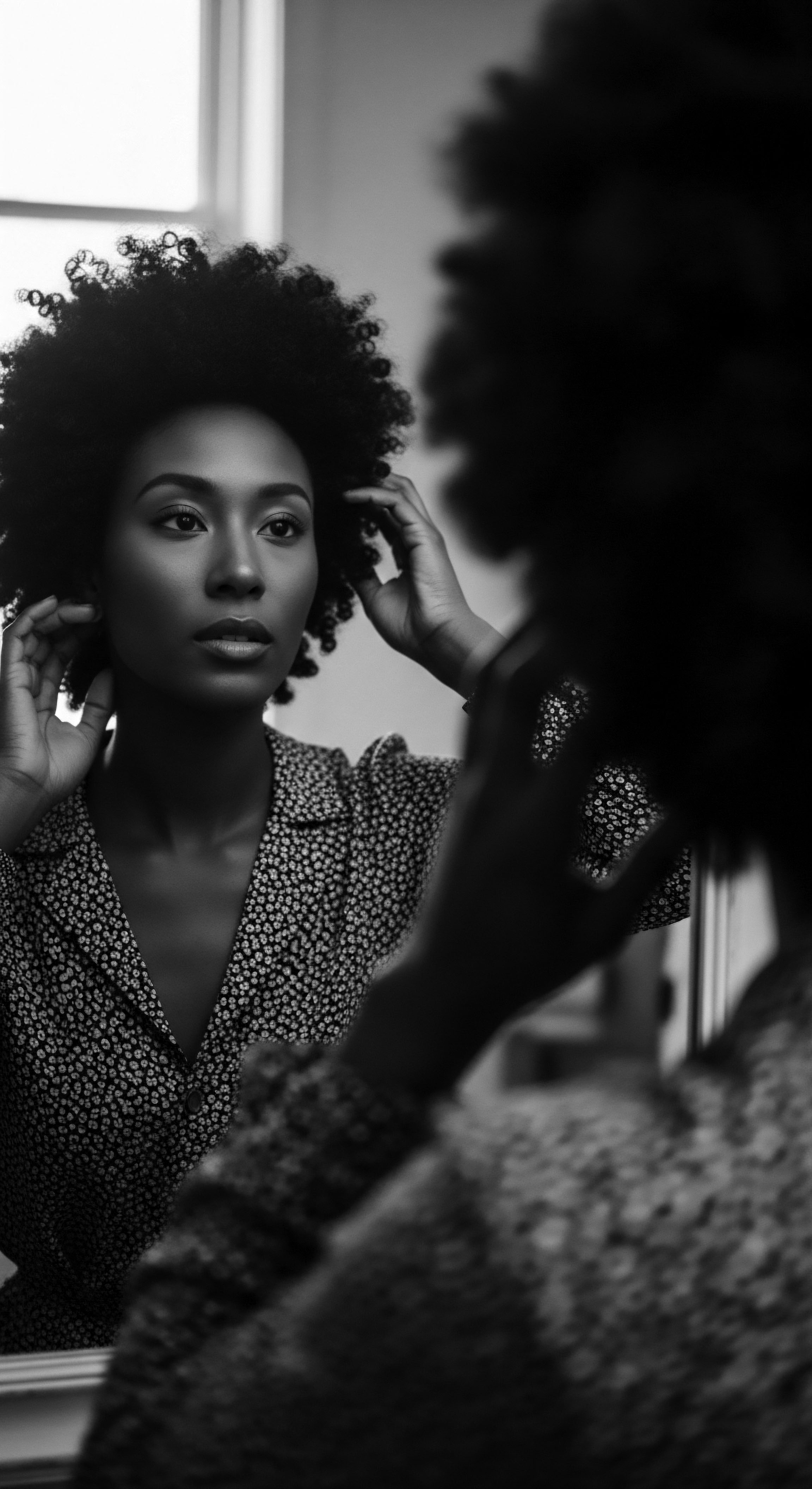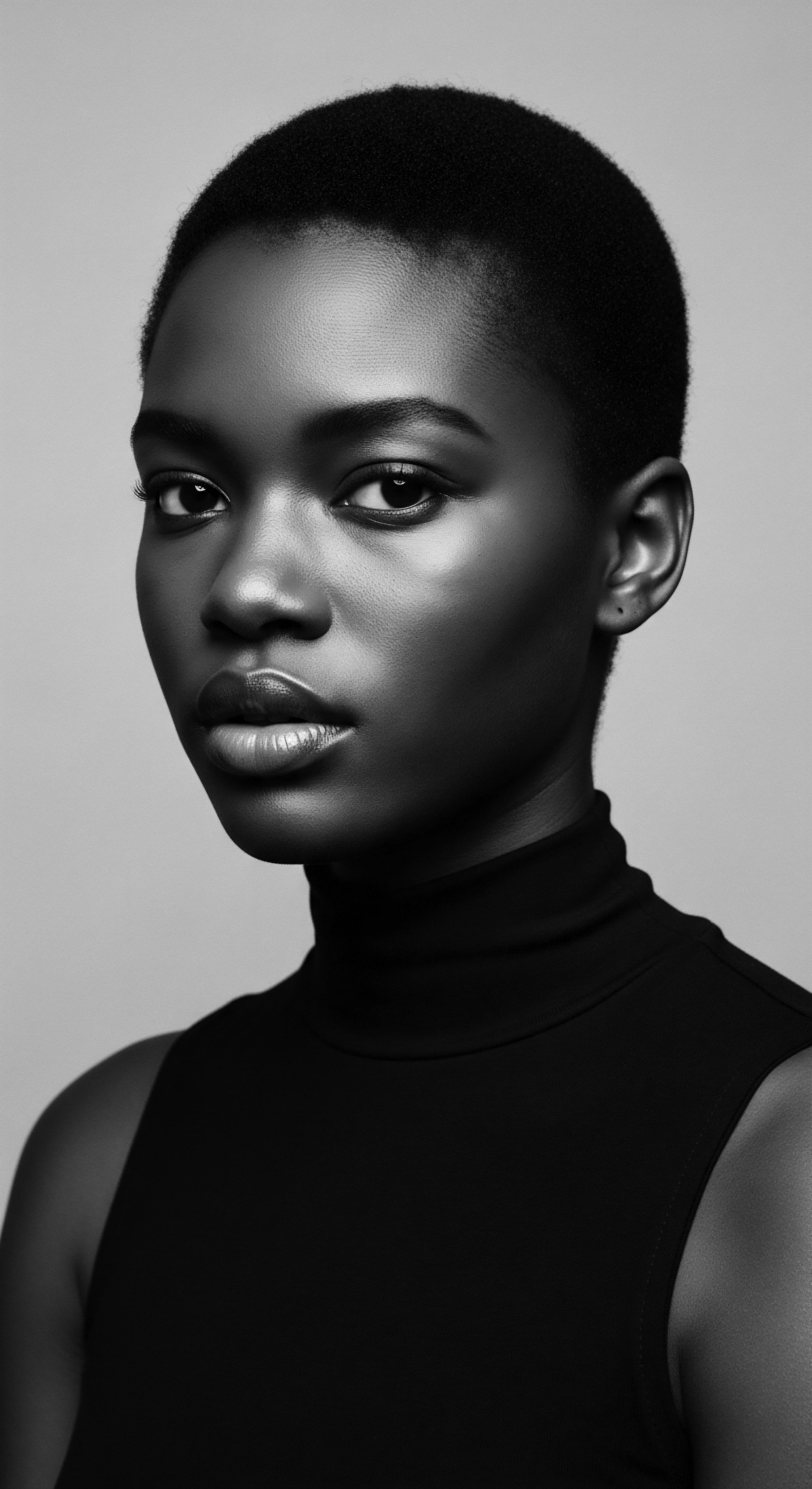
Roots
Our strands, each a chronicle, hold ancestral whispers. To truly comprehend how cleansing textured hair unfolds in our present, we must first turn our gaze to the deep past, where the earliest acts of purification were not merely about hygiene but about reverence for self and connection to the earth. Imagine a time when the very act of tending to one’s crown was a ritual, a profound gesture woven into the fabric of daily existence and community life.
The ingredients employed were drawn directly from the bounty of the land, reflecting a harmony between human needs and nature’s provisions. This historical perspective, imbued with inherited wisdom, allows us to grasp the enduring legacy that shapes our current hair care philosophies and practices.

Ancestral Cleansing and Hair’s Fundamental Structure
The core biology of textured hair, with its unique helical geometry and cuticle patterns, has always influenced how it was, and is, cleansed. Unlike straighter hair types, coiled and kinky strands naturally possess more surface area, and their intricate bends can make it more challenging for natural oils to travel from the scalp down the length of the hair shaft. This inherent characteristic meant that ancestral cleansing methods were often gentle, aiming to remove excess oils and environmental buildup without stripping the hair’s vital moisture. The understanding of this balance, even without modern scientific terms, guided early practitioners toward solutions that were both effective and conditioning.
Consider the practices rooted deep within West Africa, where communities understood the necessity of maintaining the hair’s integrity. One such remarkable agent, born of this understanding, is African Black Soap, known in its traditional form as Alata Samina in Ghana or Ose Dudu in Nigeria. Crafted from the ash of plantain peels, cocoa pods, palm tree leaves, and shea tree bark, then mixed with various oils like shea butter and palm kernel oil, this traditional cleanser offered a unique blend of purification and conditioning properties. Its historical utility across West African nations as a versatile wash for both skin and hair is well-documented (Sharaibi et al.
2024, p. 555845). The plant ash components provide natural saponins, the cleansing agents that create a mild lather, while the oils counteract excessive drying, leaving the hair feeling clean yet soft.
The historical use of indigenous plant-based cleansers for textured hair underscores an innate ancestral understanding of hair’s unique hydration needs.

Earth’s Gifts ❉ Early Ingredients for Hair Purity
Long before the advent of commercial surfactants, human ingenuity led to the discovery of natural cleansing agents. Across various African communities, people utilized what was readily available.
- Clays ❉ Found particularly in North Africa, materials like Rhassoul Clay (ghassoul), sourced from the Atlas Mountains, were valued for their drawing power. This mineral-rich clay was mixed with water to form a paste, absorbing impurities and excess oil from the scalp and hair, rinsing away gently and leaving strands soft, a tradition that speaks to a deep connection with geological resources.
- Plant Saponins ❉ Beyond black soap, various plants containing natural saponins were recognized and used. For instance, the leaves of the Ziziphus Spina-Christi tree, often called Sidr, were pounded and mixed with water to create a mucilaginous paste. This was applied as a natural shampoo in parts of Ethiopia and the wider Middle East, prized for its ability to cleanse and condition simultaneously without harshness. These botanical washes were not only about cleanliness but also about imparting softness and aiding detangling.
- Herbal Infusions ❉ Many leaves, barks, and roots were steeped in water to create rinses. These were often used to address scalp health, reduce irritation, or simply to refresh the hair. The active compounds in these plants, while not always strong cleansers, often possessed antimicrobial or soothing properties that contributed to overall hair and scalp wellbeing.

What Early Understanding of Textured Hair Informed Ancestral Cleansing?
Ancestral knowledge of textured hair went beyond simple observation. It was a sophisticated, lived understanding, passed down through generations. The practice of using softer water, often rain or river water, was likely favored to help the natural cleansing agents work more effectively. The methods involved gentle massage, not aggressive scrubbing, acknowledging the delicate nature of coiled strands and their propensity for tangling.
This delicate approach helped preserve the cuticle layer, which is so vital for moisture retention in textured hair. The ingredients selected were typically those that offered a holistic benefit—not just cleaning, but also soothing the scalp, conditioning the strands, or even imparting subtle scents. These choices reflect a communal wisdom that recognized the intrinsic link between hair health, cultural identity, and wellbeing. The very act of cleansing was often a social affair, reinforcing familial bonds and community ties, transforming a necessity into a cherished ritual.

Ritual
The journey of textured hair cleansing, from its elemental origins, broadened to encompass elaborate rituals—a testament to its cultural centrality. Cleansing was rarely a solitary, utilitarian act; it was frequently a preamble to adornment, a communal experience, or a moment of personal reflection. The selection of cleansing agents and the manner of their application became part of a larger aesthetic and spiritual expression, profoundly influencing the styling traditions that followed. This intertwining of purification and personal presentation showcases the holistic approach inherent in ancestral hair practices.

Cleansing As Preparation for Adornment
For communities where hair served as a visual language—communicating status, age, marital state, or even tribal affiliation—clean hair was a foundational canvas. The laborious and often hours-long processes of braiding, twisting, or sculpting hair into intricate designs necessitated a clean, manageable base. Cleansers, therefore, were chosen not only for their purifying capabilities but also for their ability to soften the hair, make it pliable, and prepare it to hold its styled form. Ingredients offering slip, making detangling easier, were highly valued, for without ease of manipulation, the complex artistry of traditional styling would have been unattainable.
Consider the women of the Basara people in Chad, whose hair care traditions are renowned. While their ultimate secret lies in treatments like Chebe powder for length retention, the cleansing and conditioning that precede these applications are equally important. They understand the hair’s need for a gentle approach to maintain length and health.
Similarly, the use of Ambunu Leaves from Chad stands as a remarkable example of a natural ingredient that serves dual roles ❉ a cleanser and a detangler, making the hair more cooperative for traditional styling techniques. The mucilage from these leaves creates a slippery consistency, allowing fingers or traditional combs to glide through coils without causing breakage.
| Historical Ingredient African Black Soap (Alata Samina) |
| Traditional Application & Cultural Context A West African multi-purpose cleanser for hair and body; valued for its natural saponins and moisturizing oils. |
| Modern Scientific Link / Contemporary Use Contains natural glycerol and plant ash for gentle cleansing; still a popular base for natural shampoos. |
| Historical Ingredient Rhassoul Clay |
| Traditional Application & Cultural Context Used in North Africa as a mineral-rich wash for hair and skin, drawing out impurities and softening. |
| Modern Scientific Link / Contemporary Use Rich in silica, magnesium, calcium; acts as a natural absorbent and conditioner, favored in clay washes. |
| Historical Ingredient Ambunu Leaves |
| Traditional Application & Cultural Context A Chadian tradition providing a slippery, conditioning wash, aiding in detangling and minimizing hair breakage. |
| Modern Scientific Link / Contemporary Use Contains saponins and mucilage for cleansing and significant slip, used in modern natural hair routines. |
| Historical Ingredient Ziziphus Spina-Christi (Sidr) |
| Traditional Application & Cultural Context Employed in parts of Africa and the Middle East as a gentle, conditioning herbal shampoo. |
| Modern Scientific Link / Contemporary Use Contains natural saponins and mucilage, offering a mild cleansing action that also strengthens hair. |
| Historical Ingredient These ancestral elements illuminate the enduring connection between natural ingredients, mindful cleansing, and the heritage of textured hair care. |

How Did Communal Practices Shape Cleansing Traditions?
Hair care was, for many ancestral communities, a deeply communal affair. The act of washing and preparing hair often transpired in shared spaces—rivers, courtyards, or family compounds. This setting allowed for the intergenerational transfer of knowledge, where mothers taught daughters, and elders shared wisdom with the younger generations. The specific herbs to collect, the proper way to prepare the cleansing mixture, the gentle techniques for working through coily strands—all were learned through observation and hands-on guidance.
This collective involvement cemented the traditions, ensuring their passage through time. It fostered a bond, transforming a mundane task into a moment of shared heritage, reinforced with laughter, stories, and songs. The wisdom of touch, the nuance of hair density and pattern, the very ‘soul of a strand,’ was understood not through textbooks, but through these tender, shared experiences.
The tools of cleansing also bore the mark of heritage. Hand-carved wooden combs, often adorned with symbolic motifs, were used with a deliberate, gentle motion. These tools were not simply utilitarian objects; they were extensions of the care ritual itself, connecting the user to a long lineage of similar practices. The collective memory of these rituals, passed from hand to hand, from generation to generation, forms an invisible, yet potent, historical ingredient in our contemporary understanding of textured hair cleansing.

Relay
The wisdom of ancestral cleansing practices has not faded into history; it has been relayed through time, informing and influencing our contemporary understanding of textured hair care. This continuity represents a powerful heritage, a dialogue between ancient insights and modern scientific discoveries. The very compounds our ancestors instinctively sought in plants now find validation through chemical analysis, allowing for a deeper appreciation of the profound efficacy of traditional approaches. The relay of this knowledge speaks to the resilience of cultural practices and the timeless quest for holistic wellbeing.

Ancestral Echoes in Modern Cleansing Chemistry
Today’s textured hair cleansers, though often complex chemical formulations, frequently draw inspiration from the very principles discovered by our forebears. The quest for gentle yet effective cleansing, for example, mirrors the ancestral preference for plant-based saponins over harsher agents. Modern surfactants are engineered to achieve a balance ❉ lifting dirt and excess sebum without stripping the hair’s natural lipids, a goal implicitly sought when using African Black Soap or Ambunu leaves.
The understanding of pH balance, crucial for maintaining the integrity of the hair’s cuticle, finds an echo in historical practices that favored slightly acidic rinses, such as diluted fruit juices or vinegars, to close the cuticle and impart shine. These historical applications, driven by empirical observation, demonstrate an intuitive grasp of hair science long before laboratories could measure molecular interactions.
The current movement towards “clean” beauty and natural ingredients in the cosmetic industry also represents a return, in many ways, to ancestral sourcing. Consumers are increasingly seeking ingredients that are recognizable, plant-derived, and free from harsh additives. This consumer drive is, at its heart, a subconscious longing for the simplicity and perceived efficacy of historical methods.
We witness the resurgence of interest in ingredients like shea butter and various botanical extracts in modern cleansing products, directly linking back to their centuries-old uses in African hair care. The marketplace reflects this inherited appreciation, celebrating what our ancestors discovered through intimate connection with their environment.

Why Do Ancestral Cleansing Agents Still Guide Modern Formulations?
The enduring influence of ancestral cleansing agents stems from their inherent compatibility with textured hair’s unique needs and their holistic benefits. Modern science, through ethnobotanical studies, confirms the presence of valuable compounds in these traditional ingredients. For instance, the anti-inflammatory properties often present in plants used for scalp cleansing provide relief from irritation, a benefit still highly sought after today. The natural humectants and emollients found in many historical cleansing preparations helped maintain moisture, preventing the dryness that textured hair is prone to experiencing.
- Botanical Saponins ❉ Natural surfactants from plants like soapnuts or African black soap provide gentle foam and cleansing action, less harsh than synthetic detergents.
- Clays and Earth Minerals ❉ Ingredients like rhassoul clay adsorb impurities without stripping, offering mineral enrichment to the scalp.
- Herbal Conditioners and Detanglers ❉ Certain plant mucilages, like those from Ambunu leaves, provide slip and conditioning, easing the detangling process for coiled hair.
The efficacy of these traditional approaches, honed over generations of practical application and observation, continues to be a powerful guide. This is not about romanticizing the past without critical thought; it is about recognizing the deep ecological and physiological wisdom contained within these practices. They understood, perhaps intuitively, the interconnectedness of scalp health, hair resilience, and overall vitality. The relay of this knowledge ensures that the cleansing journey for textured hair remains rooted in a legacy of care that prioritizes inherent beauty and wellbeing, rather than fleeting trends.

The Problem Solving Compendium ❉ Ancestral Solutions
Beyond simple cleansing, historical ingredients also provided solutions to common hair and scalp issues. Dandruff, scalp irritation, and dryness are not modern afflictions, and ancestral communities developed remedies using their available resources. Herbal infusions known for their antiseptic or anti-inflammatory properties were often incorporated into cleansing routines to soothe an irritated scalp. Oils and butters were applied to seal in moisture after cleansing, combating dryness and preventing breakage.
The focus was consistently on maintaining a healthy scalp ecosystem, understanding that a healthy foundation supports healthy hair growth. This historical emphasis on problem-solving through natural means continues to resonate, as we seek out holistic alternatives for our hair care challenges today.
The enduring relevance of historical cleansing methods rests upon their foundational efficacy and deep-seated compatibility with textured hair’s unique requirements.

Reflection
As we close the book on this particular passage of textured hair’s heritage, the echoes of ancestral cleansing practices reverberate, reminding us that our present-day routines are not isolated acts. They are deeply connected to a continuum of wisdom, a living, breathing archive of care that stretches back through time. The ingredients once plucked from the earth—the saponin-rich plants, the mineral clays, the soothing botanicals—were not chosen by chance. They were selected through generations of intimate observation, a profound engagement with the needs of coiled strands and the very essence of human connection.
To wash textured hair, then, is more than a simple act of purification; it is an honoring. It is an acknowledgment of the resilience that allowed these traditions to persist despite challenges, to be carried across continents, and to shape the very notion of beauty within Black and mixed-race communities. Each cleansing product we choose today, whether consciously or not, carries the whispers of these forebears, reminding us that true wellness stems from recognizing our roots. This journey through historical ingredients ultimately illuminates the Soul of a Strand ❉ a recognition that our hair is not merely a biological feature, but a vibrant testament to heritage, identity, and the enduring legacy of self-care.

References
- Sharaibi, O. J. Oluwa, O. K. Omolokun, K. T. Ogbe, A. A. & Adebayo, O. A. (2024). Cosmetic Ethnobotany Used by Tribal Women in Epe Communities of Lagos State, Nigeria. Journal of Complementary Medicine & Alternative Healthcare, 12(4), 555845.
- Dube, M. & Nthoi, L. (2022). The History of Black Hair ❉ Unlocking the Secrets of African Hair Care. BLAM UK CIC.
- Mahomed, S. D. (1822). Shampooing; or Benefits resulting from the use of the Indian medicated vapour bath. (Original publication 1820).
- Etteh, C. & Oyewole, O. (2023). What Every Dermatologist Must Know About the History of Black Hair. The Dermatologist, 31(11).
- Adjanohoun, E. J. & Ake Assi, L. (1990). Traditional Medicine and Pharmacopoeia ❉ Contribution to Ethnobotanical and Floristic Studies in West Africa. Organisation of African Unity Scientific, Technical and Research Commission.
- Oyelade, O. J. (2007). African Traditional Medicine ❉ A Textbook of Traditional Healing.
- Ojo, S. A. & Owolabi, M. S. (2018). Ethnobotanical survey of plants used for cosmetic purposes in Southwest Nigeria. African Journal of Traditional, Complementary and Alternative Medicines, 15(4), 45-56.
- Abdullah, M. (2024). The History of Afro Hair ❉ A Cultural Journey. Nuevo Noir.
- Sizov, S. (2024). Cosmetopoeia of African Plants in Hair Treatment and Care ❉ Topical Nutrition and the Antidiabetic Connection? Diversity, 16(2), 96.
- Mekonnen, A. (2025). Plants used for hair and skin health care by local communities of Afar, Northeastern Ethiopia. Ethnobotany Research and Applications, 29.
